DC Retroactive 1970’s: Superman one-shot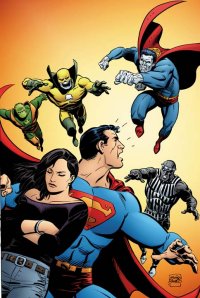
DC Retroactive 1970’s: Justice League of America one-shot
(DC Comics, $4.99 each)
by Graig Kent
I find comics from the 1960’s generally unreadable, hyper-expository to a fault. Comics of the 1970’s I enjoy a lot more, though not universally, as they evolved to a place where exposition was still common, but not a constant. Writers started trusting their artists to tell the visual story without having to continually explain to the reader what it is they were seeing, at the same time they started trusting their readers with more information, longer stories, stronger continuity, and even multiple Earths. Though the storytelling started to mature, the stories themselves were still reflective of decades past, still juvenile in their sensibilities, still answering to a comics code to regarding their content. Sure some strides were made to grow up, to tackle more mature themes like drug abuse, but for the most part comics were light, frivolous and, actually, fun… a descriptor that, by the late-’90’s was actually seen as a negative. Thankfully, things have come around again in the past decade to where fun is just as welcome as mature.
This week’s DC Retroactive 1970’s: Superman one-shot is fun in the way many of ’70’s comics were, just by the nature of their storytelling. High concept, bizarre situations, irrational leaps in logic (or irrational lapses in logic), cartoonish drama, but all coming together in a satisfying product that’s played semi-straight. It doesn’t quite take itself seriously, but it’s neither being ironic or cute, it’s just, well, having fun.
In the story, Superman’s attitude as of late has been somewhat terse (I wonder if veteran Superman scribe Martin Pasko was playing off the whole “Superman’s A Dick” meme from a decade or so ago), and the never-ending battle against the forces of evil seems especially relentless as the Master Jailer, Atomic Skull, Agents of S.K.U.L.L., Metallo and Bizarro all strike in quick succession, although they don’t seem so much themselves, and they all disappear just as quickly as the appeared. Meanwhile, things with Lois and Lana hit their usual Betty and Veronica histrionics, elevating both Clark and Superman’s stress levels even further. Is Clark just exhausted, or is there something (or someone?) more nefarious behind his recent anxiety.
Pasko’s script is suitably of the era, certainly not the type of story or storytelling you would generally find today, to the point that the leap into the back-up feature (from Action Comics #484, 1978) — an Earth 2 Superman story about how Clark and Lois got married — is not at all jarring. The art however between Eduardo Barreto/Christian Duce’s main feature and the Curt Swan/Joe Giella back-up is somewhat discordant, in part the visual storytelling language but more due to the difference in coloring. While I can understand why the choice of artists for the Retroactive 1970’s books have not really been of-the-time (Barreto is known more for his work in the ’80’s and ’90’s), it’s unfortunate that the colorists didn’t go for a more era-specific style of coloring to try and accentuate the effect the books are trying to achieve.
 While the Superman one-shot is more in the straight-laced vein of fun, the DC Retroactive 1970’s: Justice League of America one-shot is of the intentional sort. DC and Marvel have, over their long, sometimes friendly, sometimes antagonistic rivalry, traded extensively on the personalities of the creators and editorial staff. Letter columns and bullpen pages helped establish a connection between the makers and readers of comics, giving them a sense of community, like the writers and artists were friends, friens that would listen to your ideas about their books and address your complaints, and perhaps share a secret or two. One of the more playful aspect of comics of the era would find writers, editors and artists turning up for a cameo in the background or foreground of the comic, old school easter eggs for hardcore comic fans. But on rare occasions the creators would turn up as an actual character in the story, including “Earth-Prime” versions of themselves (the DC Earth that most closely resembles our own, where superheroes only exist in comic books). The JLA one-shot starts with a zeta-beam accident involving Kanjar Ro, landing Adam Strange on Earth-Prime, and requiring the JLA to mount a rescue mission. Led by Barry Allen, who had visited Earth-Prime in the past, the JLA recruit long serving DC editor Julie Schwartz to help them.
While the Superman one-shot is more in the straight-laced vein of fun, the DC Retroactive 1970’s: Justice League of America one-shot is of the intentional sort. DC and Marvel have, over their long, sometimes friendly, sometimes antagonistic rivalry, traded extensively on the personalities of the creators and editorial staff. Letter columns and bullpen pages helped establish a connection between the makers and readers of comics, giving them a sense of community, like the writers and artists were friends, friens that would listen to your ideas about their books and address your complaints, and perhaps share a secret or two. One of the more playful aspect of comics of the era would find writers, editors and artists turning up for a cameo in the background or foreground of the comic, old school easter eggs for hardcore comic fans. But on rare occasions the creators would turn up as an actual character in the story, including “Earth-Prime” versions of themselves (the DC Earth that most closely resembles our own, where superheroes only exist in comic books). The JLA one-shot starts with a zeta-beam accident involving Kanjar Ro, landing Adam Strange on Earth-Prime, and requiring the JLA to mount a rescue mission. Led by Barry Allen, who had visited Earth-Prime in the past, the JLA recruit long serving DC editor Julie Schwartz to help them.
Written by Cary Bates and co-illustrated by Gordon Purcell (handling the Earth-Prime pages) and Andy Smith (handling the Earth-One pages)– again two artists more familiar to the ’80’s and ’90’s than the ’70’s — the book is a tribute to playful, in-jokey books of the time, while still being an honest-to-gosh Justice League adventure. At the same time Bates is paying warm respects to the beloved, departed Schwartz and his editorial legacy. The back-up feature reprints Justice League of America #123, in which then-series co-writers Cary Bates and Elliott S! Maggin find Julie Schwartz’s cosmic treadmill (given to him as a gift by the Flash) and wind up on Earth-Two and Earth-One, respectively, somehow imbued with super-powers. Bates winds up a super-villain, while Maggin joins up with the Justice League. Unfortunately, the reprint presents only the first of a two-parter, but just as with the Superman one-shot, the main feature and back-up feature have a nice synergy, though the Justice League one is more complimentary to the story being told.
While the Retroactive 1970’s books have largely been enjoyable, it’s a venture that could have been better served with a little more thought put into the presentation and coordination, perhaps with essays, retro-style ads, reprinting the actual cover to the back-up feature, and back-up features that compliment the main better as only the Justice League feature seemed to. The same will likely be said of the ’80’s and ’90’s Retroactive books, but still it remains a fun (there’s that word again) excursion into the past.
DC Retroactive 1970’s: Superman one-shot — Rating: 




Out of a Possible 5 Stars
DC Retroactive 1970’s: Justice League of America one-shot –Rating:





Out of a Possible 5 Stars
Captain America & Bucky #620 (Marvel Comics, $2.99)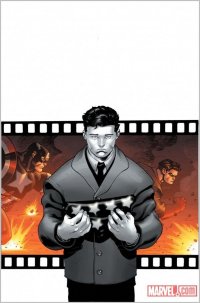
By Devon Sanders
Today’s mainstream superhero comics don’t quite seem to know just what they want to be. One minute they’re touting legacy and tradition, the next, jettisoning the bits they deem “dated” in order to appear relevant to folk who still think Superman, Robin and Captain America are dead. This week’s offering, Captain America & Bucky #620 is a particularly interesting conundrum as its focus is on the WWII exploits of Bucky, the once and future Captain America. Bucky’s a character once thought dead, discovered alive, brainwashed and working as a Soviet assassin; he much later takes up the mantle of Captain America and recently was beaten to death with his own robotic arm within the pages of Fear Itself. And now… he gets his own comic. While the the timing of this book might seem a bit weird, writer Marc Andreyko and artist Chris Samnee prove this character’s timelessness with a story of a young man standing at the beginning of legacy.
Andreyko crafts a wonderful tale of a boy forced into manhood by circumstance and forged into a solder by The U.S. Army and the results are entirely compelling and somewhat heartbreaking. Despite everything you already know about the character, Andreyko makes it all seem fresh and alive, keeping you wanting to know even more about Bucky’s journey. Tying this all together into a simply beautiful package is one of comics’ true talents, Chris Samnee.
Samnee’s art must be seen to be believed as it’s a master class in visual storytelling with its uses of lush blacks, appropriate body language, characters who actually interact with one another and panel layouts that honor the story’s need. Samnee with this issue, simply outclasses most of his contemporaries and more importantly, makes you want to revisit his work again.
Captain America and Bucky #620, a book set in Marvel’s past, is one of superhero comics’ most forward thinking books. You should really check this one out.
Rating: 




Out of a Possible 5 Stars
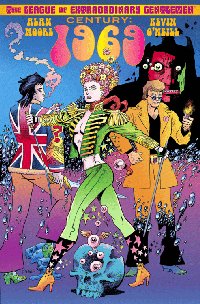 The League of Extraordinary Gentlemen: Century–1969 (Top Shelf, $9.95)
The League of Extraordinary Gentlemen: Century–1969 (Top Shelf, $9.95)By Adam Prosser
The past is a tricky thing. A historical era, while it’s happening, is complex and unknowable; once it’s gone by, however, it’s something that can be nailed down, commodified, analyzed, and defined. It becomes a subject for nostalgia. The more messy and complex aspects get sanded down or ignored altogether. The time period is reduced to a series of signifiers, a checklist of events, characters and images that we can encapsulate within our minds and feel comfortable about “knowing”. To the extent that when a story set in a historical era drifts from what we think we know, it unsettles us, makes us feel cheated.
You would think that Alan Moore’s League of Extraordinary Gentlemen, whatever else it accomplishes, would fall comfortably into the realm of nostalgia and signifiers. I mean, by definition, it’s a hit parade of all the memorable characters from a certain era. Yet, right from the beginning, LoEG has reminded us that every era contains echoes from its own past and stirrings of its future, and that the ideals and “cool bits” we remember only present a fraction of the true story. With 1969, the second in the terminally delayed three-volume Century, Moore brings this theme even further into the foreground, reminding us that “the sixties” as they’ve become ensconced in our cultural memory (especially for people like myself, who weren’t alive to see it) were, in fact, a patchwork of overlapping ideas, trends, and cultures, even when viewed through the lens of fantasy and fiction.
The Nautilus surfaces beneath the Albion Reach causeway, starting point for the original LoEG volume, depositing Mina, Alan, and the gender-bending Orlando in swinging London on a mission to tie up some loose ends from the last volume. The supposedly dead Aleister Crowley substitute Olivier Haddo has surfaced again, his cult seemingly responsible for the death of a Brian Jones-like rock star named Basil Thomas. (Longtime readers of LoEG will know that, in the world of the League, real-world celebrities are swapped out with their fictional counterparts—there’s a lot of that going on here in particular.) Haddo, in a new guise, is building to an occult exchange revolving around Thomas’s old band, led by Terner (Mick Jagger’s substitute, who also happens to be the character Jagger himself played in the Nicholas Roeg movie “Performance”). But aside from the occult undercurrent tainting the peace and love all around them, the League’s own attempts to fit in may mask some deeper, darker psychological issues.
Needless to say, LoEG has long since moved beyond the relatively straightforward adventure romp that the first and, to a lesser extent, the second volume provided. For one thing, this is now Moore’s major vessel for his esoteric ideas about culture, comics, fiction, and everything else, so the scope has expanded far beyond the pulp action that it started as. Moore’s own frustration with corporate shenanigans in the comic industry and elsewhere are also playing a role in shaping the story—there are plenty of hints that the final volume will be flat out equating the current shape of our modern culture with a fascist dictatorship for fiction (and more, it’s looking a lot like the antichrist foretold throughout “Century” will in fact be a certain Mr. Potter of Privet Drive…in fact, He Who Must Not Be Named makes an appearance in this volume, though you have to be fairly sharp-eyed to spot him.)
But that’s in the future, and this volume is focused squarely on the summer of love. As a guy who did, in fact, live through the 60s, Moore has seemingly been building to a grand statement on the decade for much of his career, and here he provides a pretty definitive overview of both the good and the bad, reminding us of some of the strange cultural tics that don’t jibe with either those who sentimentalize the time period or those who see it as the beginning of the decline of western civilization. It’s a dense and complicated work, possibly even less accessible than Black Dossier, and even the Easter eggs are going to be more obscure for all but the most avid students of the period. (And as a North American, I found the culture portrayed here was particularly unfamiliar at times.) If you’re still with this series, or Alan Moore’s work in general, the esoteric nature of this work is probably not going to come as a surprise; LoEG is now geared squarely at the hardcore, and you’re either in or you’re out. There’s no real point pining for the wiz-bang adventure narratives Moore spent much of his career cranking out; like the League itself, he’s moved on to something new. And also like the League, he knows that you have to keep trying to reach out and engage with the world and the culture…even if your experiences send you to the loony bin.
Rating: 




Out of a Possible 5 Stars
Amazing Spider-Man #666 (Marvel, $3.99)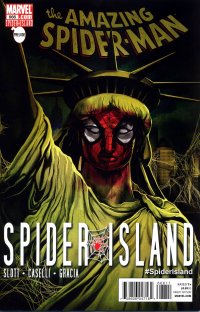
By Jeb D.
Thank god for Dan Slott. I will admit to being only an occasional Spider-Man reader, and for the past few years (really, since the amazing Slott/Templteton Spidey-Human Torch mini), it seems as though the only times I’ve got much out of the wall-crawler’s adventures, Slott’s name has been on the masthead (Mark Waid from time to time, too). And as Marvel gets ready to launch this year’s silliest sounding crossover (Spider-Island?), it’s nice to be eased into it by a guy so completely at home with that balance of incredible convolution, and pure storytelling, that is the hallmark of the best superhero comics.
Did you know that Spidey no longer has his Spider-Sense? Me neither. But not only does Dan Slott know it (I assume he’s responsible for it), he finds clever and humorous ways to illustrate the non-obvious impact that can have on our hero’s life (I won’t spoil the one involving Ben Grimm’s card game). Did you know that the Peter-MJ relationship has been retconned yet again since the events of One More Day? News to me. And don’t even get me started on the insanely complicated Flash Thompson situation. But Slott drops in enough casual references to let the slow kids like me keep up without derailing the story.
And it’s a pretty good story so far, as Slott shows us just how contented Peter is with the current state of his life… and just how thinly he’s stretched; Slott even manages to poke some fun at the commercial necessity of having Spidey appear in half the company’s books. And, given that, and the loss of his Spider-Sense, he’s not seeing the weird transformations that New Yorkers are undergoing; for all that I was dismissive, up above, of the overall title of the storyline, the idea of Manhattan’s geographical isolation becoming a trap feels very promising. I won’t spoil more of what happens here, but it’s frankly a setup issue, and Stefano Caselli’s startling final page is just the summation of the excellent work he provides throughout; he can be inconsistent from page to page or even panel to panel, but most of the time he goes all-out for facial expressions and background detail, with gorgeous results.
Yeah, it’s a “prelude,” but a good one, and I ‘m thankful that Marvel didn’t get gimmicky with the whole “666” thing by bringing back Mephisto or whatever (I know there’s a big multi-cover promotion going on in conjunction with this issue, but I’ve only seen the one posted here). I think it might be time to settle myself back in to regular reading of Amazing Spider-Man.
Rating: 




Out of a Possible 5 Stars
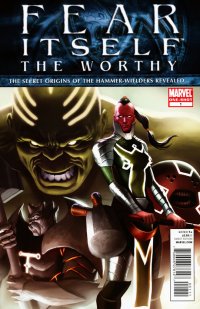 Fear Itself: The Worthy #1 (Marvel, $3.99)
Fear Itself: The Worthy #1 (Marvel, $3.99)
By Jeb D.
The problem isn’t big crossover events: they’re not inherently bad, they can be well-written, and much of the fun of a shared superhero universe is exactly that kind of character mashup. And when we were kids, and you could buy several comics with the change in your jeans, this stuff was great.
But we’re not kids anymore, and the industry is most definitely not what it was back in the day: comics are no longer cheap entertainment, but collectors’ investments, and the barrier to enjoyment of a crossover event is less one of time or opportunity, than the simple fact that comics are damned expensive; no matter how curious a reader might be to see what would happen if, say, Titania and the Grey Gargoyle were recruited into an army of evil super-hammer-throwers, there’s a value-for-money equation that needs to be done here. And The Worthy #1 comes out, if only just barely, on the positive side of that equation.
At fifty pages of story and art, this assortment of introductory pieces is a decent value, since most of the creative teams do manage to make some impact in just a few pages. Mind you, there is an argument to be made that most of the exposition could have been done in-continuity, in a comic where the overall plot actually advances, but that’s a two-edged sword: anyone not knowing, say, the recent history of the Fantastic Four wouldn’t exactly benefit from having a couple of characters, in mid-fight, exchanging their thoughts about Johnny Storm’s death, or the Future Foundation: it would get the information across, but distract from what’s taking place. So on that basis, I’d say that there was at least some justification for assembling all these recap/introduction pieces into this collection (this also implies, of course, that anyone not reading this might be completely lost in some of the other tie-in books).
As to the specifics, we have the convoluted backstory (well, let’s face it-they’re ALL pretty convoluted) of Sin presented by Christos Gage and Elia Bonetti (a name new to me, but who I’m not surprised to find has worked on Cap, since he has a nice Epting-like style); Titania from Jan Van Meter and Clayton Henry; the latest retelling of the Hulk story from Greg Pak with terrific old-school art by Lee Weeks; Attuma is his usual boring self at the hands of Tom DeFalco and Mario Alberti; and Crusher Creel gets a nicely cartoony intro from Tom Peyer and Sergio Cariello.
Particularly worthy of note are the nuanced presentation of the Grey Gargoyle by Frank Tieri and Eric Canete, and the genuinely moving and visually striking Ben Grimm-Sue Richards encounter from Robert Aguirre-Sasca and Javier Pulido. And while it’s not quite as punchy (so to speak) as those segments, the Juggernaut section (by Jeff Parker and Declan Shalvey) is a model of what a story like this should do: it catches up on, and interlocks with, Juggy’s place in the current run of Thunderbolts, and how that’s going to impact this book and the overall Fear Itself storyline.
If you think you’re coming down with Event Fatigue, then you haven’t even read this far. If you enjoy seeing comic creators exploring the possibilities inherent in the interactions of an entire universe full of crazily spandexed characters, this makes a fun accompaniment to Fear Itself.
Rating: 




Out of a Possible 5 Stars